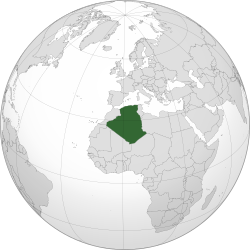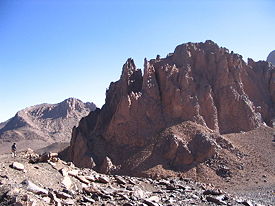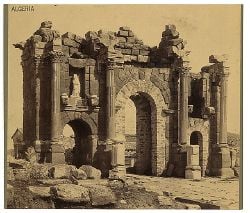Algeria
| People's Democratic Republic of Algeria اÙج٠ÙÙرÙØ© اÙجزائرÙØ© اÙدÙÙ ÙراطÙØ© اÙØ´ÙعبÙØ©Â (Arabic) al Jumhuriyya al JazÄ'iriyya ad-DÄ«muqrÄÅ£iyya ash Sha'biyya République algérienne démocratique et populaire (French) |
||||||
|---|---|---|---|---|---|---|
|
||||||
| Motto: " باÙØ´Ùعب ÙÙÙØ´Ùعب " (Arabic) "By the people and for the people"[1] |
||||||
| Anthem: " ÙسÙ
Ùا " (Arabic) We Pledge |
||||||
| Capital (and largest city) | Algiers | |||||
| Official language(s) | Arabic ⢠Berber (Tamazight) | |||||
| National languages | Algerian Arabic (Darja) (lingua franca) French (administration, business and education)[2] |
|||||
| Demonym | Algerian | |||||
| Government | Unitary semi-presidential constitutional republic | |||||
| Â -Â | President | Abdelmadjid Tebboune | ||||
| Â -Â | Prime Minister | Abdelaziz Djerad | ||||
| Establishment | ||||||
|  - | Numidia | from 202 BC | ||||
|  - | Roman Republic | from 46 BC | ||||
|  - | Vandal Kingdom | from 430 | ||||
|  - | Rustamid dynasty | from 767 | ||||
|  - | Zirid dynasty | from 973 | ||||
|  - | Hammadid dynasty | from 1014 | ||||
|  - | Abdalwadid dynasty | from 1235 | ||||
|  - | Ottoman Caliphate | from 1516 | ||||
|  - | French rule | from 1830 | ||||
| Area | ||||||
|  - | Total | 2,381,741 km2 (11th) 919,595 sq mi |
||||
|  - | Water (%) | negligible | ||||
| Population | ||||||
| Â -Â | 2021Â estimate | 44,700,000[3]Â (32nd) | ||||
|  - | Density | 17.7/km2 (168) 47/sq mi |
||||
| GDPÂ (PPP) | 2019Â estimate | |||||
| Â -Â | Total | |||||
| Â -Â | Per capita | |||||
| GDP (nominal) | 2019Â estimate | |||||
| Â -Â | Total | |||||
| Â -Â | Per capita | |||||
| Gini (2011) | 27.6[5] | |||||
| HDIÂ (2019) | ||||||
| Currency | Algerian dinar (DZD) |
|||||
| Time zone | CET (UTC+01) | |||||
| Drives on the | right | |||||
| Internet TLD | .dz | |||||
| Calling code | 213 | |||||
The People's Democratic Republic of Algeria, commonly referred to as Algeria, is a nation in North Africa and is the second largest country on the African continent. It is bordered by Tunisia in the northeast, Libya in the east, Niger in the southeast, Mali and Mauritania in the southwest, and Morocco as well as a few kilometers of its annexed territory, Western Sahara, in the west. In the Constitution of Algeria, it is defined as an Islamic, Arab, and Amazigh (Berber) country. The name Algeria is derived from the name of the city of Algiers, and officially from the Arabic language word al-jazÄâir which translates as "the islands." These islands refer to islands which lie off that city's coast.
Algerian society has considerable historical depth and has been subjected to a number of external influences and migrations. Fundamentally Berber in cultural and racial terms, the society was organized around extended family, clan, and tribe and was adapted to a rural rather than an urban setting before the arrival of the Arabs and, later, the French.
Algeria has been dominated by several cultures, most recently, the French. Since its independence, Algeria has suffered internal strife from the many factions inside its borders. While the economy is on the rise due to increase in oil and monetary policies of the International Monetary Fund, freedoms of society are restricted due to a repressive government and religious differences.
Geography
Algeria comprises 2,381,741 square kilometers of land, more than four-fifths of which is desert, in northern Africa, between Morocco and Tunisia. It is the second largest country in Africa, after Sudan. Its Arabic name, Al Jazair (the islands), derives from the name of the capital Algiers (Al Jazair in Arabic), after the small islands formerly found in its harbor. It has a long Mediterranean coastline. The northern portion, an area of mountains, valleys, and plateaus between the Mediterranean Sea and the Sahara Desert, forms an integral part of the section of North Africa known as the Maghreb. This area includes Morocco, Tunisia, and the northwestern portion of Libya known historically as Tripolitania.
Stretching more than 600 kilometers eastward from the Moroccan border, the High Plateaus (often referred to by their French name Hauts Plateaux) consist of undulating, steppe-like plains lying between the Tell and Saharan Atlas ranges.
Higher and more continuous than the Tell Atlas, the Sahara Atlas range is formed of three massifs: the Ksour near the Moroccan border, the Amour, and the Oulad Nail south of Algiers.
Eastern Algeria consists of a massive area extensively dissected into mountains, plains, and basins. It differs from the western portion of the country in that its prominent topographic features do not parallel the coast. In its southern sector, the steep cliffs and long ridges of the Aurès Mountains create an almost impenetrable refuge that has played an important part in the history of the Maghrib since Roman times. Near the northern coast, the Petite Kabylie Mountains are separated from the Grande Kabylie range at the eastward limits of the Tell by the Soummam River. The coast is predominantly mountainous in the far eastern part of the country, but limited plains provide hinterlands for the port cities of Bejaïa, Skikda, and Annaba.
The Algerian portion of the Sahara extends south of the Saharan Atlas for 1,500 kilometers to the Niger and Mali frontiers. The desert is an otherworldly place, scarcely considered an integral part of the country. Far from being covered wholly by sweeps of sand, however, it is a region of great diversity. Immense areas of sand dunes called areg (sing., erg) occupy about one-quarter of the territory.
The desert consists of readily distinguishable northern and southern sectors, the northern sector extending southward a little less than half the distance to the Niger and Mali frontiers. The north, less arid than the south, supports most of the few persons who live in the region and contains most of the desert's oases. Sand dunes are the most prominent features of this area's topography, but between the desert areas of the Grand Erg Oriental and the Grand Erg Occidental (Great Western Erg) and extending north to the Atlas Saharien are plateaus, including a complex limestone structure called the M'zab where the M'zabite Berbers have settled. The southern zone of the Sahara is almost totally arid and is inhabited only by the Tuareg nomads and, recently, by oil camp workers. Barren rock predominates, but in some parts of Ahaggar and Tassili-n-Ajjer alluvial deposits permit garden farming.
Climate and hydrology
Northern Algeria is in the temperate zone and has a mild, Mediterranean climate. It lies within approximately the same latitudes as southern California and has somewhat similar climatic conditions. Its broken topography, however, provides sharp local contrasts in both prevailing temperatures and incidence of rainfall. Year-to-year variations in climatic conditions are also common.
In the Tell Atlas, temperatures in summer average between 21 and 24 °C and in winter drop to 10 to 12 °C. Winters are not particularly cold, but the humidity level is high. In eastern Algeria, the average temperatures are somewhat lower, and on the steppes of the High Plateaux, winter temperatures hover only a few degrees above freezing. A prominent feature of the climate in this region is the sirocco, a dusty, choking south wind blowing off the desert, sometimes at gale force. This wind also occasionally reaches into the coastal Tell.
In Algeria, only a relatively small corner of the torrid Sahara lies across the Tropic of Cancer in the torrid zone. In this region even in winter, midday desert temperatures can be very hot. After sunset, however, the clear, dry air permits rapid loss of heat, and the nights are cool to chilly. Enormous daily ranges in temperature are recorded.
Rainfall is fairly abundant along the coastal part of the Tell Atlas, ranging from 400 to 670 mm annually, the amount of precipitation increasing from west to east. Precipitation is heaviest in the northern part of eastern Algeria, where it reaches as much as 1000 mm in some years. Farther inland, the rainfall is less plentiful. Prevailing winds that are easterly and north-easterly in summer change to westerly and northerly in winter and carry with them a general increase in precipitation from September through December, a decrease in the late winter and spring months, and a near absence of rainfall during the summer months. Algeria also has ergs, or sand dunes between mountains, which in the summer time when winds are heavy and gusty, temperatures can rise to 110 °F (43 °C).
History
Algeria is rich in prehistoric memorials of human occupation, especially in megalithic remains, of which nearly every known kind has been found in the country. Numerous flints of palaeolithic type have been discovered, notably at Tlemcen and Kolea. Near Djelfa, in the Great Atlas, and at Mechra-Sfa ("ford of the flat stones"), a peninsula in the valley of the river Mina not far from Tiaret, are vast numbers of megalithic monuments. Notable among the prehistoric cultures of the area is the Capsian culture, whose shell-mounds are found throughout the north.
Algeria has been inhabited by Berbers or Imazighen since at least 10,000 B.C.E. From 1,000 B.C.E. onward, the Carthaginians became an influence on these peoples, establishing settlements along the coast. Berber kingdoms began to emerge, most notably Numidia. They seized the opportunity offered by the Punic Wars to become independent of Carthage only to be taken over soon after by the Roman Republic in 200 B.C.E. As the western Roman Empire collapsed, the Berbers became independent again in much of the area. The Vandals overtook parts of the area until later expelled by the generals of the Byzantine Emperor, Justinian I. The Byzantine Empire then retained a precarious grip on the east of the country until the coming of the Arabs in the eighth century.
Algeria was brought into the Ottoman Empire by Khair ad Din and his brother Aruj. They established Algeria's modern boundaries in the north and made its coast a base for the corsairs. Acts of piracy committed upon American vessels in the Mediterranean resulted in the First Barbary War and Second Barbary War with the United States.
On the pretext of a slight to their consul, the French invaded Algiers in 1830. The intense resistance made for a slow conquest of Algeria, which was not technically completed until the early 1900s when the last Tuareg were conquered.
Meanwhile, however, the French made Algeria a colony of France, declaring it French Algeria in 1860. Tens of thousands of settlers from France, Italy, Spain, and Malta moved in to farm the Algerian coastal plain and occupy the most prized parts of Algeria's cities. They benefited from the French government's confiscation of communally held land, and the application of modern agriculture techniques that increased the amount of arable land. Beginning towards the end of the nineteenth century, people of European descent in Algeria (the so-called pied-noir), as well as the native Algerian Jews (typically Sephardic in origin), became full French citizens; by contrast, the vast majority of Muslim Algerians, even veterans of the French army, received neither French citizenship nor the right to vote.
Algerian War of Independence
The Algerian War of Independence (1954â1962), brutal and long, was the most recent major turning point in the country's history. Although often fratricidal, it ultimately united Algerians and seared the value of independence and the philosophy of anticolonialism into the national consciousness. Abusive tactics of the French Army remains a controversial subject in France to this day.
In the early morning hours of November 1, 1954, the National Liberation Front (FLN) launched attacks throughout Algeria in the opening salvo of a war of independence. An important watershed in this war was the massacre of civilians by the FLN near the town of Philippeville in August 1955. The government claimed it killed 1,273 guerrillas in retaliation; according to the FLN, 12,000 Muslims perished in an orgy of bloodletting by the armed forces and police, as well as colon gangs. After Philippeville, all-out war began in Algeria.
After nearly a decade of urban and rural warfare, the leader of the French forces, Gen. Charles De Gaulle, initiated a referendum in which the Algerian people could decide their own fate. In July, 1962 the Algerians voted for independence. The Evian accords also provided for continuing economic, financial, technical, and cultural relations, along with interim administrative arrangements until a referendum on self-determination could be held. The Evian accords guaranteed the religious and property rights of French settlers, but the perception that they would not be respected led to the exodus of one million (about ten percent of the population) pieds-noirs and harkis.
Between one and two million Algerians are estimated to have died during the war, and an additional two or three million, out of a total Muslim population of nine or ten million, became refugees or forcibly relocated into government-controlled camps. Much of the countryside and agriculture was devastated, along with the modern economy, which had been dominated by urban European settlers (the pied-noirs). These nearly one million people of mostly French descent were forced to flee the country at independence due to the unbridgeable rifts opened by the civil war and threats from units of the victorious FLN; along with them fled Algerians of Jewish descent and those Muslim Algerians who had supported a French Algeria. Post-war infighting, armed chaos and lynch trials of supposed traitors contributed to tens of thousands of deaths after the pullback of French troops, until the new Algerian government, led by Ben Bella, was able to secure control.
Socialization
Algeria's first President, the FLN leader Ahmed Ben Bella, was overthrown by his former ally and defense minister, Houari Boumédiènne in 1965. Under Ben Bella the government had already become increasingly socialist and dictatorial, and this trend continued throughout Boumedienne's government; however, Boumedienne relied much more heavily on the army, and reduced the sole legal party to a merely symbolic role. Agriculture was collectivized, and a massive industrialization drive launched. Oil extraction facilities were nationalized, increasing the state's wealth, especially after the 1973 oil crisis. The Algerian economy became increasingly dependent on oil, bringing hardship when the price collapsed in the 1980s.
In foreign policy, Algeria was a member and leader of the 'non-aligned' nations. Dissent was rarely tolerated, and the state's control over the media and the outlawing of political parties other than the FLN was cemented in the repressive constitution of 1976. President Boumédienne died in 1978, but the rule of his successor, Chadli Bendjedid, was only slightly more open. The state took on a strongly bureaucratic character and corruption was widespread.
The modernization drive brought considerable demographic changes to Algeria. Village traditions underwent significant change as urbanization increased, new industries emerged, agriculture was substantially reduced, and education, a rarity in colonial times, was extended nationwide, raising the literacy rate from less than 10 percent to over 60 percent. Improvements in healthcare led to a dramatic increase in the birthrate (7-8 children per mother) which had two consequences: a very youthful population, and a housing crisis. The new generation struggled to relate to the cultural obsession with the war years and two conflicting protest movements developed: left-wingers, including Berber identity movements, and Islamic 'intégristes'. Both protested against one-party rule but also clashed with each other in universities and on the streets during the 1980s. Mass protests from both camps in autumn 1988 forced Benjedid to concede the end of one-party rule, and elections were announced for 1991.
Algerian Civil War
The Algerian Civil War was an armed conflict between the Algerian government and various Islamist rebel groups which began in 1991. It is estimated to have cost between 150,000 and 200,000 lives. The conflict effectively ended with a government victory, following the surrender of the Islamic Salvation Army and the 2002 defeat of the Armed Islamic Group. However, low-level fighting still continues in some areas.
The conflict began in December 1991, when the government cancelled Algerian National Assembly elections, after the first round results had shown that the Islamic Salvation Front (FIS) party would win, citing fears that the FIS would end democracy. After the FIS was banned and thousands of its members arrested, Islamist guerrillas rapidly emerged and began an armed campaign against the government and its supporters.
Many of the thousands killed were often in unprovoked massacres of civilians. The question of who was responsible for these massacres remains controversial among academic observers; many were claimed by the Armed Islamic Group. After 1998, the war waned, and by 2002 the main guerrilla groups had either been destroyed or had surrendered. Even though amnesty was an option, sporadic fighting continued in some areas. Elections resumed in 1995, and on April 27, 1999, after a series of short-term leaders representing the military, Abdelaziz Bouteflika was elected president.
The issue of Berber language and identity increased in significance, particularly after the extensive Kabyle protests of 2001. The near-total boycott of local elections in Kabylie caused the government to respond with concessions, including naming of Tamazight (Berber) as a national language and teaching it in schools.
Government
The Algerian head of state is the President of the Republic, who is elected to a 5-year term, renewable once. Algeria has universal suffrage. The President is the head of the Council of Ministers and of the High Security Council. He appoints the Prime Minister of Algeria who is also the head of government. The Prime Minister appoints the Council of Ministers.
The Algerian parliament is bicameral, consisting of a lower chamber, the National People's Assembly (APN), with 380 members, and an upper chamber, the Council Of Nation, with 144 members. The APN is elected every five years.
Military
Algeria is a leading military power in North Africa and has its force oriented toward its western Morocco and eastern Libya borders. Its primary military supplier has been the former Soviet Union, which has sold various types of sophisticated equipment under military trade agreements, and the People's Republic of China. Algeria has attempted, in recent years, to diversify its sources of military material.
Foreign Relations
Algeria has traditionally practiced an activist foreign policy and in the 1960s and 1970s was noted for its support of Third World policies and independence movements. Algerian diplomacy was instrumental in obtaining the release of U.S. hostages from Iran in 1980, and in ending the Iran-Iraq War. Since his inauguration, President Bouteflika worked to improve Algeria's international reputation, traveling extensively throughout the world. In July 2001, he became the first Algerian President to visit the White House in 16 years. He has made official visits to France, South Africa, Italy, Spain, Germany, the People's Republic of China, Japan, and Russia, among others, since his inauguration.
Algeria has taken the lead in working on issues related to the African Continent. Host of the Organisation of African Unity Conference in 2000, Algeria also was key in bringing Ethiopia and Eritrea to the peace table in 2000. It has worked closely with its African neighbors to establish the New African Partnership. Algeria has taken a lead in reviving the Union of the Arab Maghreb with its regional neighbors.
Since 1976, Algeria has supported the Polisario Front, a group claiming to represent the population of Western Sahara, which is based among the 160,000 Sahrawi refugees who reside in refugee camps in Algeria. Contending that the Sahrawis have a right to self determination under the United Nations Charter, Algeria has provided the Polisario with material, financial, and political support and sanctuary in southwestern Algeria's Tindouf Province. U.N. involvement in the Western Sahara includes MINURSO, a peacekeeping force, and UNHCR, for refugee assistance and resettlement. Active diplomatic efforts to resolve the dispute under the auspices of the Special Representative of the Secretary General are on-going. Although the land border between Morocco and Algeria was closed in the wake of a terrorist attack, the two have worked at improving relations. Algeria has friendly relations with its other neighbors in the Maghreb, Tunisia and Libya, and with its Sub-Saharan neighbors, Mali and Niger. It closely monitors developments in the Middle East and has been strong proponent of the rights of the Palestinian people, calling publicly for an end to violence in the Occupied Palestinian Territories.
Algeria has diplomatic relations with more than 100 foreign countries, and over 90 countries maintain diplomatic representation in Algiers.
International disputes: part of the southeastern region is also claimed by Libya; Algeria supports exiled Western Saharan Polisario Front and rejects Moroccan administration of Western Sahara; some countries question its use of capital punishment.
Economy
The fossil fuels energy sector is the backbone of Algeria's economy.
Algeriaâs financial and economic indicators improved during the mid-1990s, in part because of policy reforms supported by the International Monetary Fund (IMF) and debt rescheduling from the Paris Club. Algeriaâs finances in 2000 and 2001 benefited from an increase in oil prices and the governmentâs tight fiscal policy, leading to a large increase in the trade surplus, record highs in foreign exchange reserves, and reduction in foreign debt. The government's continued efforts to diversify the economy by attracting foreign and domestic investment outside the energy sector has had little success in reducing high unemployment and improving living standards. In 2001, the government signed an Association Treaty with the European Union that will eventually lower tariffs and increase trade. In March 2006, Russia agreed to erase $4.74 billion of Algeria's Soviet Union-era debt during a visit by President Vladimir Putin to the country, the first by a Russian leader in half a century. In return, president Abdelaziz Bouteflika agreed to buy $7.5 billion worth of combat planes, air-defense systems and other arms from Russia, according to the head of Russia's state arms exporter Rosoboronexport.
Algeria also decided in 2006 to pay off its full $8bn (£4.3bn) debt to the Paris Club group of rich creditor nations before schedule. The Paris Club said the move reflected Algeria's economic recovery in recent years. Rich in oil and gas, it has benefited from high energy prices.[7]
Demographics
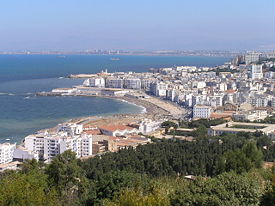
About 70 percent of Algerians live in the northern, coastal area. This includes the area along the Mediterranean Sea. The minority who inhabit the Sahara Desert are mainly concentrated in oasis, although some 1.5 million remain nomadic or partly nomadic.
During the colonial period there was a large European, primarily French pied-noir population. They were concentrated on the coast and formed a majority in certain cities. Almost all of this population left during or immediately following Algeria's independence from France.
Over 90 percent of the Algerian population adhere to Islam, mostly the Sunni branch. Other religions are restricted to extremely small groups, mainly of foreigners. Nearly all of Algeria's population is classified ethnically as Arab/Berber. Europeans account for less than 1 percent of the population. The Berbers inhabited Algeria before the arrival of Arab tribes during the expansion of Islam, in the seventh century. The issue of ethnicity and language is sensitive after many years of government marginalization of Berber (or Imazighen, as some prefer) culture.
Today, the Arab-Berber issue is often a case of self-identification or identification through language and culture, rather than a racial or ethnic distinction. The 20 percent or so of the population who self-identify as Berbers, and primarily speak Berber languages (also termed Tamazight) are divided into several ethnic groups, notably Kabyle (the largest) in the mountainous north-central area, Chaoui in the eastern Atlas Mountains, Mozabites in the M'zab valley, and Tuareg in the far south.
Language
Algeria's official languages are Arabic and Berber or Tamazight. French is the lingua franca. The most widely spoken language is a dialect called "Darja" (Algerian Arabic), which is spoken by some 80 percent of the population.
The language issue is politically sensitive, particularly for the Berber minority, which was disadvantaged by state-sanctioned Arabization. Language, politics, and Arabization were partly a reaction to the fact that 130 years of French colonization left both the state bureaucracy and much of the educated upper class completely Francophone. There has also been an influence of Arab nationalism which was promoted by successive Algerian governments.
French is still the most widely studied and spoken foreign language. English is also spoken but not commonly. Since independence, the government has pursued a policy of linguistic Arabization of both its education and bureaucracy, with some success. Many university courses continue to be taught in French.
Culture
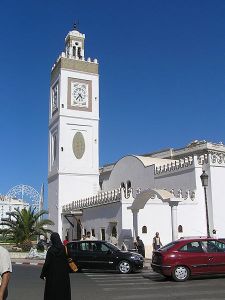
Modern Algerian literature, split between Arabic and French, has been strongly influenced by the country's recent history. List of Famous Algerian novelists of the 20th century include Mohammed Dib, Albert Camus, and Kateb Yacine, while Assia Djebar is widely translated. Important novelists of the 1980s included Rachid Mimouni, later vice-president of Amnesty International, and Tahar Djaout, killed by an Islamist group in 1993 for his secularist views.[8]
In philosophy and the humanities, Malek Bennabi and Frantz Fanon are noted for their thoughts on decolonization, while Augustine of Hippo was born in Tagaste, (about 60 miles from the present day city of Annaba), and Ibn Khaldun, though born in Tunis, wrote the Muqaddima while residing in Algeria.
The Algerian music genre best known abroad is raï, a pop-flavored, opinionated take on folk music, featuring international stars such as Khaled and Cheb Mami. However, in Algeria itself the older, highly verbal chaabi style remains more popular, with such stars as El Hadj El Anka or Dahmane El Harrachi. The tuneful melodies of Kabyle music, exemplified by Idir, Ait Menguellet, or Lounès Matoub, have a wide audience. For more classical tastes, Andalusian classical music, brought from Al-Andalus by Morisco refugees, is preserved in many older coastal towns.
In painting, Mohammed Khadda and M'Hamed Issiakhem are notable figures at the turn of the century.
UNESCO World Heritage Sites in Algeria
There are several UNESCO World Heritage Sites in Algeria:
- Al Qal'a of Beni Hammad
- Casbah of Algiers
- Djémila
- M'Zab Valley
- Tassili n'Ajjer
- Timgad
- Tipasa
Notes
- â Constitution of Algeria Article 12 Retrieved February 10, 2021.
- â CIA, Algeria: People and Society The World Factbook. Retrieved February 10, 2021.
- â Démographie Algerienne 2019 Office National des Statistiques. Retrieved February 10, 2021.
- â 4.0 4.1 4.2 4.3 World Economic Outlook Database: Algeria International Monetary Fund. Retrieved February 10, 2021.
- â GINI index (World Bank estimate) World Bank. Retrieved February 10, 2021.
- â United Nations, Human Development Report 2020 The Next Frontier: Human Development and the Anthropocene (United Nations, 2021, ISBN 978-9211264425).
- â La Russie efface la dette algérienne Radio France International, March 10, 2006. Retrieved February 10, 2021.
- â About the Book Silence Is Death: The Life and Work of Tahar Djaout by Julija Å ukys, University of Nebraska Press. Retrieved February 10, 2021.
ReferencesISBN links support NWE through referral fees
- Ageron, Charles-Robert. Modern Algeria. A History from 1830 to the Present. Translated from French and edited by Michael Brett. London: Hurst, 1991. ISBN 978-0865432666.
- Aghrout, Ahmed, and Bougherira, Redha M. Algeria in Transition: Reforms and Development Prospects. Routledge, 2004. ISBN 978-0415348485
- Bennoune, Mahfoud. The Making of Contemporary Algeria: Colonial Upheavals and Post-Independence Development, 1830â1987. Cambridge U.K.: Cambridge University Press, 1988. ISBN 9780521301503.
- Fanon, Frantz. The Wretched of the Earth. Grove Press, 1966. ISBN 978-0802141323.
- Horne, Alistair. A Savage War of Peace: Algeria 1954â1962. Viking Adult, 1977. ISBN 978-0670619641.
- Laouisset, Djamel. A Retrospective Study of the Algerian Iron and Steel Industry. New York: Nova Publishers, 2009. ISBN 0902548267.
- Roberts, Hugh. The Battlefield: Algeria, 1988â2002. Studies in a Broken Polity. London: Verso, 2003. ISBN 978-1859846841.
- Ruedy, John. Modern Algeria: The Origins and Development of a Nation. Bloomington, IN: Indiana University Press, 1992. ISBN 978-0253349989.
- Stora, Benjamin. Algeria, 1830â2000. A Short History. Ithaca, NY: Cornell University Press, 2001. ISBN 978-0801437151.
External links
All links retrieved July 20, 2023.
- Algeria CIA World Factbook
- El Mouradia official presidential site (in French and Arabic)
- allAfrica.com - Algeria news headline links
- OECD DEV/AfDB - Country Study: Algeria
- Algeria Watch human rights organization critical of widespread torture practiced by the régime (in French)
Credits
New World Encyclopedia writers and editors rewrote and completed the Wikipedia article in accordance with New World Encyclopedia standards. This article abides by terms of the Creative Commons CC-by-sa 3.0 License (CC-by-sa), which may be used and disseminated with proper attribution. Credit is due under the terms of this license that can reference both the New World Encyclopedia contributors and the selfless volunteer contributors of the Wikimedia Foundation. To cite this article click here for a list of acceptable citing formats.The history of earlier contributions by wikipedians is accessible to researchers here:
- Algeria history
- Archeology_of_Algeria history
- History_of_Algeria history
- Foreign_relations_of_Algeria history
- Geography_of_Algeria history
The history of this article since it was imported to New World Encyclopedia:
Note: Some restrictions may apply to use of individual images which are separately licensed.


